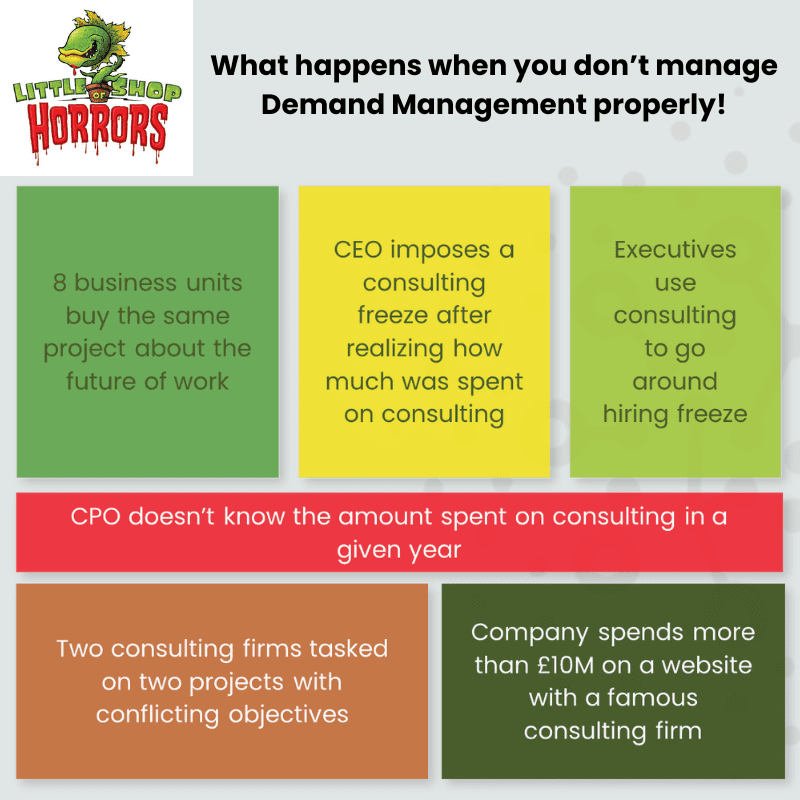Ah, demand management! Like all good things in life, when it’s good, it’s very, very good, but when it’s bad…well, let’s just say, things can get hilariously out of hand. So, for a moment, let’s swap the dreary boardrooms for a comedy club’s stage and delve into some knee-slapping, cringe-worthy, and downright uproarious misapplications of demand management for consulting services principles.
Some of these tales are so outlandish they seem like the stuff of legends. But believe it or not, these eyebrow-raising misadventures in demand management are grounded in reality. As you read on, remember: we’re not crafting fiction here. These are real, often face-palm worthy situations that businesses have encountered.
So, buckle up and prepare for some laughter, a bit of disbelief, and perhaps a silent nod of “been there, done that.”
1. The Ever-Approving CEO
Imagine a kind-hearted CEO who cannot bear to say ‘no’ to any project that lands on their desk. While fostering a spirit of affirmation and positivity, this strategy quickly spirals out of control. Departments, taking advantage of the CEO’s ever-green light policy, start pitching projects left, right, and center.
What was intended to be a controlled, hierarchical approval process now resembles an episode of “Yes Man”, with the CEO inadvertently sanctioning every conceivable project, from building a company theme park to embarking on a quest for the perfect office coffee. The aftermath? A backlog of approved projects that could take decades to complete and a budget that’s ballooning faster than a hot air balloon festival.
What Should be Done Instead
Centralizing decision-making authority in one individual, such as the CEO, carries inherent risks. For starters, the CEO’s office door can metaphorically swing more frequently open for some than others, leading to unequal access.
Additionally, even the most astute leaders have their own biases, and these can inadvertently influence their decisions. Finally, putting all decisions through one funnel can create a bottleneck, slowing down processes and stalling potential innovations. To counteract these challenges, companies should establish structured decision workflows. These workflows should:
Categorize Demands
Group demands based on project nature, its scale, who is asking, and who is footing the bill. Such categorization not only brings clarity but also ensures that similar projects undergo similar scrutiny.
Use Strategic Committees for Larger Projects
These committees, comprised of experts from various departments, can provide diverse perspectives, ensuring that a project’s evaluation is comprehensive. This minimizes the risks of overlooking potential pitfalls or benefits.
Implement Budget Oversight
This ensures every project not only stays within its fiscal boundaries but also aligns with wider organizational objectives. This way, businesses can avoid unnecessary or impulsive expenditures.
Encourage Team Decision-Making
A collaborative approach reduces the potential for bias, brings in a diverse range of perspectives, and lessens the likelihood of creating internal hierarchies based on access to the decision-maker.
By embracing these strategies, organizations can make more informed, unbiased decisions, fostering a culture of equality and ensuring that every project receives the consideration it deserves.
2. The Magical Number: €49,999.99
Enter the corporate world’s open secret – the magical number of €49,999.99. Organizations initially introducing a €50k threshold for project approval hoped to instill a sense of fiscal responsibility. However, this led to a comic surge in projects conveniently budgeted at just a penny shy of the threshold.
This budgetary loophole turned into a company-wide inside joke, with departments dancing merrily around the golden number, creating a graph of project costs that resembles a mountain range with a peak exactly at €49,999.99. In the process, the consulting tail didn’t just grow; it staged a full-blown, no-holds-barred explosion, leaving finance teams scratching their heads in bewildered amusement.
What Should Be Done Instead
The art of implementing demand management in consulting isn’t about creating a maze of approvals; it’s about striking the right balance between flexibility and control. Implementing a tiered approval system based merely on budgetary constraints will only add to the bureaucracy and might even hamper innovation.
Instead, organizations should focus on:
Value and Strategy Alignment
Every project, irrespective of its budget, should be evaluated based on its alignment with the company’s strategic objectives and potential ROI. Those that promise significant strategic advancement or higher ROI should be prioritized.
Differentiated Scrutiny
While it’s essential to have a tiered system, the focus shouldn’t just be on the budget. Projects should be scrutinized based on their strategic importance, potential impact, and risks involved.
Stakeholder Autonomy with Accountability
Provide stakeholders with budgetary autonomy for smaller projects, allowing them to make decisions quickly without getting entangled in red tape. However, ensure there’s a system of accountability and post-project evaluation to keep things transparent and on track.
Streamlined Approval for High-Impact Projects
Not every project needs the CEO’s attention. Create a committee or group responsible for assessing and green-lighting projects of significant strategic importance or higher budgets. This reduces the CEO’s decision-making burden and allows for more comprehensive scrutiny from various perspectives.
Maintain Flexibility
While it’s essential to have controls, they shouldn’t be so rigid that they stifle innovation. Create a system where unconventional projects or those outside typical budgetary confines can be evaluated separately, ensuring no potential game-changer is nipped in the bud due to procedural constraints.
Ultimately, the aim of demand management is to ensure the company’s resources are optimally used to push the organization forward in its strategic journey, not to create hurdles that stymie progress.

3. The Impractical Principles: All Gear, No Idea
Then, we have organizations that erected strict and towering guidelines like a fortress, but alas, forgot to equip their teams with the proverbial keys to the kingdom. Teams found themselves gazing up at the towering expectations, lacking the resources, authority, and training to actually execute their strategies.
Picture teams equipped with state-of-the-art tools and zero knowledge on how to use them effectively, leading to an absurdist theater of trial and error that Beckett could not have scripted better.
What Should Be Done Instead
Before flipping the switch and demanding internal teams to rise to the challenge, companies must first conduct a comprehensive internal assessment. Is the heavy reliance on consultants truly due to a lack of in-house resources? Or is it perhaps a skills gap or a temporary surge in demand?
Instead of the knee-jerk reaction of simply turning off the consultancy tap, organizations should be asking: What’s the root cause of this dependency? If there’s a genuine lack of resources, consider expanding the team or offering training to upscale current employees. Should the expertise be a long-term need, perhaps it’s time to internalize certain consultant roles.
The way forward isn’t to barricade the doors without offering a way out. It’s to strategically map the landscape, identifying where reinforcements are needed and then equipping teams with the necessary tools, knowledge, and authority to move forward confidently. This approach not only ensures tasks are carried out effectively but also cultivates a sense of ownership and empowerment among team members.
4. The Multi-Tool Fiasco
Next on stage is the multi-tool fiasco. Organizations, in their zest to leverage the best in tech, fragmented their demand management workflows across various platforms. Imagine needing to reference five different manuals to assemble a single piece of furniture; that’s the reality of these companies.
The promise of a consolidated view vanished like a mirage, leaving teams running a cross-country marathon, leaping from one platform to another in a frantic relay of confused communication and lost data.
What Should Be Done Instead
In an era where digital transformation is steering business strategies, it’s perplexing that some organizations still grapple with disparate ERP systems, creating siloed data streams. While each ERP might serve its purpose, the lack of a unified view can muddy the waters of decision-making.
Instead of wrestling with fragmented tools, organizations should consider the benefits of specialized best-of-breed digital procurement tools. These tools, designed with specific functionalities in mind, can seamlessly bridge gaps between different ERPs.
Moreover, when it comes to intricate demands like consulting, vertical procurement tools – ones tailored for a single category – can be a game-changer. With their customizable solutions, these tools can cater precisely to the nuances of consulting needs, ensuring both clarity and flexibility.
In essence, while it might be tempting to stick to traditional ERPs, there’s undeniable value in embracing specialized procurement tools. They not only integrate data streams but also tailor the process to the unique challenges and opportunities presented by each procurement category.
5. The Voice (Not the TV Show)
Lastly, we spotlight organizations where demand management turned into a reality TV show dubbed “The Voice – Corporate Edition”. Instead of strategic planning and thorough analyses, the game was won by the loudest voice in the room.
Boardrooms turned into battlegrounds of decibels, where pitches resembled power ballads more than business proposals. It became less about the merits of a project and more about the theatrical prowess of the presenter, transforming strategic discussions into dramatic performances worthy of Broadway.
What Should Be Done Instead
In rugby, the saying “No scrum, no win” underscores the foundational significance of the scrum. A team that doesn’t secure its scrums finds itself on the back foot, under constant pressure, and with limited options to launch successful plays.
Similarly, in business, without a clearly defined foundational strategy, you’re essentially playing without securing your scrums. You’re open to undue influences and can find your decisions constantly pressured by those with louder voices rather than solid strategies.
To shift away from reactive decision-making, organizations need to first outline and communicate a clear overarching strategy. This becomes the bedrock upon which all projects and initiatives are evaluated.
From this strategy, specific guidelines, thresholds, and criteria can be derived, ensuring that the decision-making process is anchored in the company’s broader goals, rather than who presents the most compelling or loudest argument.
With this approach, businesses can ensure they’re launching their initiatives from a position of strength and clarity, rather than reacting to internal pressures. It’s about turning your business game around, securing your scrums, and setting the stage for powerful, strategic plays.
Conclusion: Demand Management for Consulting Services
Implementing demand management in consulting isn’t just another tick in the corporate checklist. It’s akin to a seasoned captain steering a ship through unpredictable waters, using both intuition and the best navigational tools available.
While the waters of business are filled with numerous challenges, from the all-approving CEOs to those sneaky 49.99k€ projects, the core principle remains: Navigate with both caution and purpose.
Effective demand management for consulting services, at its heart, is about fostering a delicate balance between agility and structure. While tales of misguided strategies might elicit a chuckle or two, they underscore the pressing need for a robust, yet flexible, system.
Companies need to rise above the mere bureaucracy of signatures and delve into the genuine essence of demand management: ensuring every resource spent aligns with the organization’s strategic compass.
As the world of business continuously evolves, challenges will undoubtedly present themselves in newer forms. But with a strong foundation in value-driven demand management, organizations can not only face these challenges head-on but can also turn them into stepping stones towards a brighter, more efficient future. After all, in the grand game of corporate strategy, it’s not just about avoiding mistakes but leveraging every opportunity to its fullest potential.
demand management demand management demand management
demand management demand management demand management
demand management demand management demand management

How Consource Can Help?
With Consource, you can implement demand management by leveraging our flexible workflows to build on geographies, capabilities, business units, or functions. Leverage costs, impact, and ROI calculations for each project to monitor results to make informed decisions, reducing the likelihood of errors, oversights, and inefficiencies in the process.








0 Comments